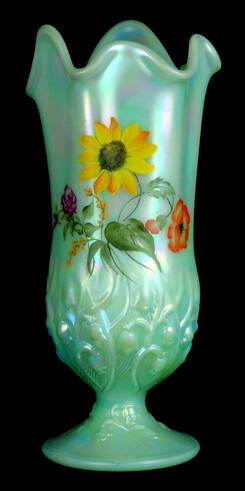Moulds!
Moulds, and the expertise of the skilled glassmakers who used them, were essential ingredients in the making of Carnival Glass - after all, the generally accepted definition of Carnival Glass is "iridised glass with a moulded pattern".
We have written many times about the versatility of moulds, and (because of their value to the glassmaking factories) the need to maximise the variety of shapes and finishes that were achieved from them. It was clearly emphasised to us in the 1990s when our good friend, (the late) Howard Seufer, organised a very special visit for us to the Fenton factory. He arranged a brilliant practical demonstration for us of the variety of shapes and sizes of glass that could be made from a single mould in the hands of an expert glassmaking team.
This is the mould they used. The pattern is Lily of the Valley - a 3-part mould which looks like a footed, straight-sided large goblet shape. The picture is courtesy of the Fenton Family and Fenton Art Glass Company.
Fenton's Lily of the Valley mould.
The colour that was "in the line" at the time was Champagne Opalescent - a delicate shade of pale pink with a great depth of opal, and because we were Carnival enthusiasts, Howard arranged for the pieces to be given a light iridescent treatment which perfectly complemented the delicate pink opal glass.
Here are the four pieces that were made right in front of our eyes - all from the same mould!
|
All four pieces were expertly hand-finished after they were taken out of the mould and whilst the glass was still hot and malleable. The flared-out comport (third from the left, and also shown below) is the closest piece to being the "as moulded" shape: the straight sides of the item when it came from the mould were flared out, whilst constantly turning the piece to ensure a consistent, even flared shape. It is 4½" tall and 5" across the flared top. The bud vase (second from the left, and also here on the right) was shaped and pulled into this very elegant vase shape which is slightly over 10 " tall. The footed plates are two different sizes: one is 6¼" across, and the slightly larger one is 7". The variations that the glassmakers created were not limited to shape alone. In this case, they also created different iridescent effects for us. The underside of the larger footed plate has a lovely multi-coloured satin iridescence (below left), whereas the upper surface of the smaller footed plate has a fantastic iridescent "stretch" effect (below right). The "stretch" effect was created by re-heating the item after it had been given its iridescent spray. The piece with the satin iridescence was not re-heated after being sprayed. So much versatility from a single mould ... and with a huge amount of skill! |
|
And one more (very unexpected) treat for us, courtesy of Howard.
In our article, "The Art and Craft of Mouldmaking - We made a Mould .... and a Plunger .... with Fenton!", we explained step-by-step, how Glen (Thistlewood) was commissioned to design a mould and plunger for a Carnival club commemorative souvenir, and how we worked with Fenton to make it a reality. Again, we want to put on record our gratitude and debt to Howard Seufer who mentored, advised and acted as the go-between between Glen and Fenton at every stage along the way. After the first souvenirs had been pressed, we were stunned to receive an item to commemorate the occasion - the vase shown on the right and yes, it came from the very same Lily of the Valley mould. In this case the team created a pulled and iridised vase, with a further embellishment: the very talented Frances Burton, a Fenton decorator, had hand painted it with Glen's "Flowers of the World" design. |







